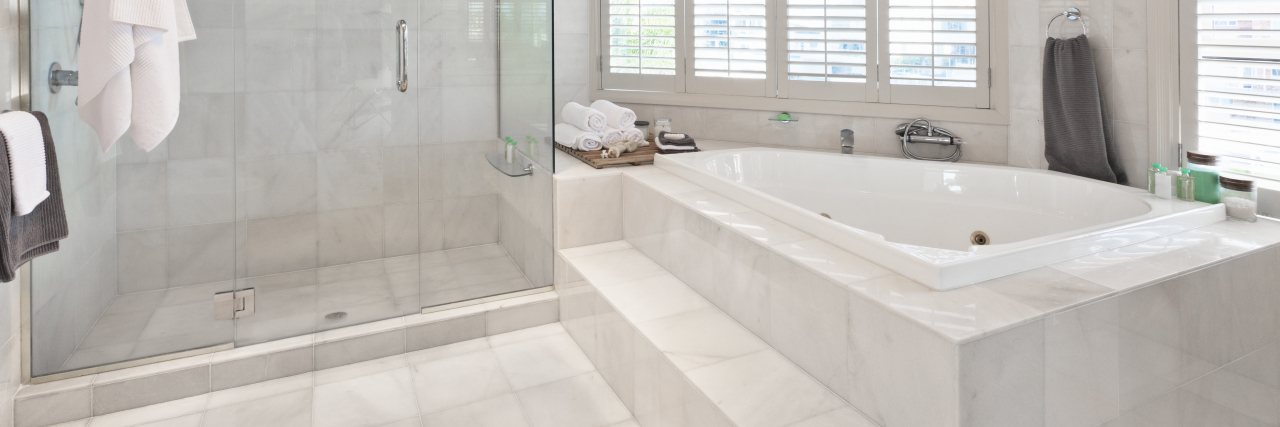I was terrified of the shower.
Yes, my absolute favorite household appliance, the source of calming warm water, soothing bubble baths and daily self-care, recently scared the living daylights out of me.
Let me rewind a bit.
My family and I eagerly awaited a week-long getaway to paradise. As we arrived at our hotel room, dreaming of warm, sandy beaches and plumeria-filled bliss, we darted from room to room, exclaiming how cozy the beds looked and “oooohing” and “ahhhhhing” over the spacious 1.5-bath setup.
It was the latter that would eventually alarm me, forcing me to wonder if it was even remotely safe for me to enjoy.
I walked into the larger bathroom, expecting a shower with a flat entrance and a grab bar gracing the left side of the wall. After all, thanks to accessibility laws, that’s the way the bathrooms always seem to look, so this one would be more of the same, right?
Wrong. Dead wrong.
Instead, I found myself gaping at a large, extremely deep tub surrounded by a thick marble ledge. A small, vertical metal bar rested at chest level at the right-side end of the tub.
Shocked, I stared helplessly at the shower, which probably conjured up images of peaceful candlelit bubble baths for most hotel patrons. But where they saw comfort, I saw hazard — a lengthy series of gymnastics that would almost certainly result in a perilous fall to the bottom of the tub.
I nervously gripped the too-small grab bar with both hands and hoisted my stiff, cerebral palsy-affected leg over the marble ledge, hoping and praying I wouldn’t fall. But I nearly lost my balance, sending my unaffected leg knocking into the decorative marble.
Getting out of the tub after lathering myself in soap and shampoo proved even more daunting. My feet were drenched in water, which made scaling the deep marble ledge and not slipping with my soaked appendages seem nearly insurmountable.
Thankfully, I traversed the perilous-looking tub without a single fall for the duration of the trip. Despite my lucky, safe landings, the configuration of the hotel shower left me feeling angry and defeated.
My cerebral palsy is so mild that I’ve never had to worry about how best to contort my body to get in and out of a shower. I can typically go virtually anywhere and do practically anything without worrying about accessibility, but on this trip, a seemingly innocuous shower nearly took me out.
It dawned on me that if I, with my occasional clumsiness and slightly stiff leg, could barely safely step into a shower, that particular shower configuration would be completely inaccessible to those with more involved cerebral palsy. That moment at the entrance of the shower was a stark reminder that yes, I’m disabled, but I’m also physically privileged enough to be able to access an “inaccessible” living space.
It hurt me to think that so many of my peers wouldn’t be able to enjoy such a seemingly simple pleasure and that so many others would have to set their bodies into overdrive to access a structure many able-bodied people would brush off as “accessible enough.”
In many cases, “accessible” doesn’t mean “accessible for all.” Many establishments attempt to adhere to the ADA by placing grab bars in inconvenient, inaccessible locations and building ramps into buildings that are internally inaccessible. While those sparse “accommodations” may work for some people with disabilities, they still prevent less ambulatory people from accessing “accessible” structures, which renders those areas completely inaccessible.
Accessibility must be universally applicable. Public establishments must be designed (both externally and internally) to accommodate people with a range of conditions, needs and physical abilities. Instead of shoddily creating inaccessible “access” merely out of a sense of legal obligation, businesses should focus on their moral obligation to allow all consumers the equal opportunity to enjoy their facilities to the fullest. And of course, building contractors should consult with people with a wide variety of disabilities to ensure their work is truly accessible to those who typically have difficulty accessing buildings and restrooms.
Only when our society prioritizes true accessibility will the disability community no longer need to worry about the steep stairs and deep shower tubs their able-bodied peers scale with ease. It’s our responsibility to create a world in which anyone, regardless of ability, can take a warm, carefree soak in the shower — without any potential physical repercussions.
Getty image by EP Stock.

